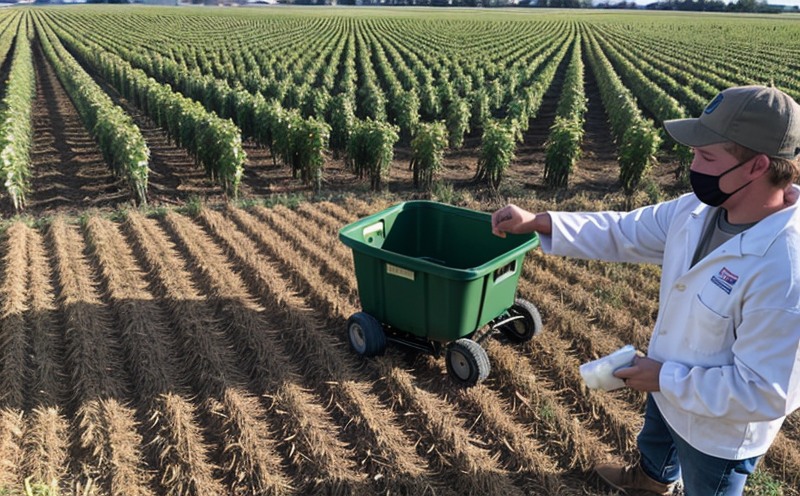Post-Harvest Microbial Load Testing
In the agricultural and forestry sectors, post-harvest quality testing is crucial to ensure that produce remains safe and of high quality from the moment it leaves the field until it reaches consumers. Post-harvest microbial load testing plays a pivotal role in this process by assessing the presence and levels of microorganisms such as bacteria, yeasts, and molds on harvested products. This service ensures compliance with international standards and helps prevent spoilage, contamination, and potential foodborne illnesses.
Microbial growth can occur during storage, transport, and handling after harvesting. Factors like temperature, humidity, and the presence of nutrients contribute to this growth. Post-harvest microbial load testing identifies these microorganisms early in the supply chain, allowing for timely interventions such as refrigeration, packaging modifications, or chemical treatments. This proactive approach not only enhances product safety but also improves shelf life, reduces waste, and maintains brand integrity.
For instance, fruits like apples and oranges have high water content, making them susceptible to microbial spoilage if not handled properly post-harvest. Similarly, grains and pulses can harbor molds that produce mycotoxins under improper storage conditions. By conducting regular microbial load tests, facilities in the agricultural and forestry sectors can monitor these risks effectively.
Microbial testing is conducted using various methods depending on the product type. For perishable items like fresh fruits and vegetables, rapid culture-based techniques are often employed to quickly identify spoilage-causing organisms. In contrast, for grains and pulses, mycotoxin screening tests may also be performed concurrently to assess mold contamination levels.
The process typically involves sampling the produce at different stages of handling or storage, followed by laboratory analysis using media plates, agar-based cultures, or more advanced molecular techniques like PCR (Polymerase Chain Reaction). The results provide a quantitative measure of microbial load, which helps in establishing appropriate intervention thresholds and control measures.
Compliance with international standards such as ISO 14644:2019 for cleanroom environments or ASTM E2583-15 for the use of chemical sanitizers is essential. These guidelines ensure that testing protocols are consistent across different regions, enhancing confidence in the quality and safety of agricultural products.
Regular monitoring through post-harvest microbial load testing also aids in understanding regional variations and seasonal influences on microbial growth rates. This knowledge helps producers tailor their handling practices to mitigate risks effectively. For example, data collected from multiple harvests can reveal trends that suggest specific times when increased vigilance is needed due to higher microbial activity.
Why It Matters
The importance of post-harvest microbial load testing cannot be overstated in the agricultural and forestry sectors. Ensuring food safety and quality is paramount not only for maintaining consumer trust but also for safeguarding public health. Microbial contamination can lead to serious health issues, including gastrointestinal illnesses, which underscores the necessity of rigorous testing protocols.
From a business perspective, microbial load testing supports sustainability efforts by minimizing waste through improved handling practices. It helps reduce spoilage rates and extends shelf life, leading to increased profitability for producers. Additionally, compliance with regulatory standards enhances market access opportunities in both domestic and international markets.
Furthermore, this service aids in preventing reputational damage that could result from product recalls or health scares linked to microbial contamination. By proactively identifying and addressing potential issues, companies can avoid costly disruptions to their supply chains and maintain a positive brand image.
Benefits
- Enhanced Food Safety: Detects harmful microorganisms early in the supply chain, preventing contamination of processed products.
- Improved Shelf Life: Identifies and mitigates factors contributing to spoilage, extending product freshness.
- Increased Profitability: Reduces waste through better handling practices, leading to cost savings for producers.
- Compliance Assurance: Ensures adherence to international standards such as ISO 14644 and ASTM E2583.
- Market Access: Facilitates easier entry into global markets by meeting stringent regulatory requirements.
- Risk Management: Provides actionable insights for producers on managing microbial risks effectively.
- Sustainability: Contributes to environmental sustainability by minimizing waste and resource usage.
Quality and Reliability Assurance
The reliability of post-harvest microbial load testing is underpinned by a robust quality management system (QMS) that adheres strictly to industry best practices. Our laboratory employs certified personnel trained in microbiological techniques, ensuring accurate and consistent results. Rigorous calibration procedures are implemented for all analytical equipment used during testing.
To maintain high standards of accuracy, our facility operates under strict environmental controls that comply with ISO 17025 requirements. This ensures that the samples are handled correctly from collection to final analysis. Our approach also includes regular validation studies and proficiency testing exercises conducted by reputable organizations such as AOAC International or EURACHEM.
Our commitment to quality extends beyond our laboratory operations into the field, where we offer training sessions for farmers and handlers on best practices for minimizing microbial load during harvesting and post-harvest handling. This holistic approach ensures that every step in the supply chain contributes positively towards maintaining product integrity.
In summary, our post-harvest microbial load testing service is designed to provide comprehensive support to clients across the agricultural and forestry sectors. By leveraging advanced analytical techniques and stringent quality controls, we help ensure safe, high-quality products throughout their journey from farm to fork.





